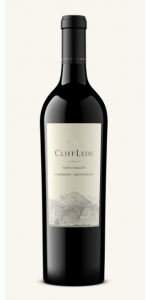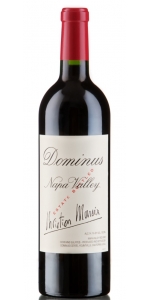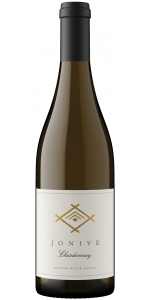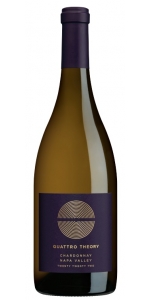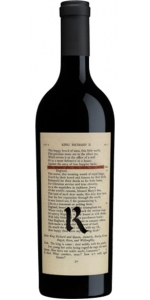Hoopes Chardonnay Napa Valley 2021
6 bottles with free shipping for: $210.00
12 bottles with free shipping for: $384.00
| BUY MORE! SAVE MORE! | ||||||||||||||||||||
|
| Country: | United States |
| Regions: | California California (Napa) |
| Winery: | Hoopes Vineyard |
| Grape Type: | Chardonnay |
| Organic: | Yes |
| Vintage: | 2021 |
| Bottle Size: | 750 ml |
Hoopes Chardonnay Napa Valley is made from 100 percent Chardonnay.
Serendipity was in the morning air when Maya and Sophie took Lindsay for a walk down a Yountville country lane. Maya, the feisty one, spied a jackrabbit and bounded off in hot pursuit. When Lindsay caught up with her, she found herself surrounded by some fine looking Chardonnay vines. Always on the look-out for the best fruit for Hoopla, with some neighborhood super-sleuthing, Lindsay tracked down the vineyard owner and kept talking until she got his handshake. That chance discovery gave us really great Chardonnay that we offer at a really great price. In fact, chasing rabbits is exactly what we’re talking about. This cheeky Chardonnay will make you want to get into some mischief too.
Our goal with the Hoopla Chardonnay is a fresh juicy wine showcasing flavors and aromas of the grape. A long cool fermentation and aging in stainless steel shines helps preserve the luscious aromas and fruit characters in the wine. Classic notes of fresh pineapple, ripe pear and Fuji apple greet the nose with a lovely warmth and creaminess in the mouth from aging sur-lie in tank without the introduction of oak. This mid-palate breadth yields to an open, clean and refreshing finish. We find ourselves reaching for this crowd-pleasing wine time and time again without fail.
This wine is delicious with roast chicken and buttery mashed potatoes, fish tacos, Chinese chicken salad, lobster mac and cheese, triple crème Brie slathered on French baguette and salt & pepper flavored kettle-cooked potato chips.
Hoopes Vineyard is a small, family-owned winegrower and producer with deep roots in Napa Valley. The estate is now run by second-generation proprietor, Lindsay Hoopes. Raised on the farm by her wine-loving family, Lindsay learned how to cultivate grapes and promote Napa’s sense of place and terroir through her father, Spencer Hoopes. Spencer Hoopes loved farming, and developed a passion for wine as the wine industry in Napa blossomed right around him.
Hoopes' vineyards are heritage vineyards, mostly from the 1980’s and 1990‘s and grafted from “suitcase” clones of unknown origin. They are very unique to Napa’s early heritage. Indeed, Hoopes has the oldest pre-Phylloxera vineyard in Oakville. That site in particular remains a sought-out destination by wine educators and enthusiasts alike because it is a telescope into some older farming techniques and Napa’s agricultural history. This vineyard is Hoopes' flagship vineyard, and was the fruit source for the first vintage of Hoopes Family Vineyard wine. They still farm and produce from this vineyard today.
Hoopes cares deeply about sustainability efforts, and intend to shepherd the land for multiple generations to come. All of their vineyards are Certified Organic or are undergoing certification. The vineyards are working, regenerative farms complete with animals, water recycling systems, and bio-diversity practices aimed at enhancing the overall health of their vineyard ecosystem.
Hoopes Chardonnay Napa Valley is made from 100 percent Chardonnay.
Serendipity was in the morning air when Maya and Sophie took Lindsay for a walk down a Yountville country lane. Maya, the feisty one, spied a jackrabbit and bounded off in hot pursuit. When Lindsay caught up with her, she found herself surrounded by some fine looking Chardonnay vines. Always on the look-out for the best fruit for Hoopla, with some neighborhood super-sleuthing, Lindsay tracked down the vineyard owner and kept talking until she got his handshake. That chance discovery gave us really great Chardonnay that we offer at a really great price. In fact, chasing rabbits is exactly what we’re talking about. This cheeky Chardonnay will make you want to get into some mischief too.
Our goal with the Hoopla Chardonnay is a fresh juicy wine showcasing flavors and aromas of the grape. A long cool fermentation and aging in stainless steel shines helps preserve the luscious aromas and fruit characters in the wine. Classic notes of fresh pineapple, ripe pear and Fuji apple greet the nose with a lovely warmth and creaminess in the mouth from aging sur-lie in tank without the introduction of oak. This mid-palate breadth yields to an open, clean and refreshing finish. We find ourselves reaching for this crowd-pleasing wine time and time again without fail.
This wine is delicious with roast chicken and buttery mashed potatoes, fish tacos, Chinese chicken salad, lobster mac and cheese, triple crème Brie slathered on French baguette and salt & pepper flavored kettle-cooked potato chips.
Review:
"I was blown away by the 2020 Chardonnay, a clean, crisp, vibrant expression of Chardonnay that has medium to full-bodied richness, wonderfully integrated acidity, and a distinct sense of minerality in its citrus, stone fruit, and white flower-driven aromatics. It's shockingly good and tastes like it cost 3-4 times its price."
- Jeb Dunnuck (February 2023), 96 pts
Clif Lede Cabernet Sauvignon Stags Leap is made from 82% Cabernet Sauvignon, 8% Merlot, 7% Cabernet Franc, 3% Petit Verdot.
Our Stags Leap District and Calistoga estate vineyards build the foundation of this wine with support from valued grower sites located in Oakville, Rutherford, and Howell Mountain. Composed of small batches from a variety of blocks of varying age, this wine represents a diverse range of carefully selected rootstocks and clones. Yields are maintained at sparse levels, with a focus on canopy management and vine balance. The resulting blend boasts a remarkable depth and complexity that is quintessential Napa Valley.
Grapes were picked in the darkness of the early morning hours. The freshly-harvested fruit immediately underwent rigorous selection by our three-tiered sorting process, which included our cutting-edge optical sorter. Whole berries were gently delivered by gravity to tank using our crane system, minimizing disruption of berry integrity. Cold soaks lasted approximately seven days, and fermentations were managed via a combination of délestage, pumpovers, and punchdowns. Extended maceration ranging from four to five weeks fine-tuned our tannin profiles, allowing us to perfect mouth feel and wine complexity. The wine was aged in French oak barrels, 48% of which were new, for twenty-one months.
Elegantly soft and lithe the 2021 coaxes the taster with warm dark chocolate and luscious black cherry aromas. More graphite, chocolate cake, crushed mulberries, and iron notes leap from the glass. The entry is filled with dark fruit flavors of cassis, blackberry, and blue berries and they’re all tinged with floral notes of jasmine and violets. The polished tannins along the finish feel Cashmere-like and beg the taster for another sip. – Christopher Tynan, Director of Winemaking
Review:
So silky and drinkable at the first sip, this well-concentrated wine feels tight and restrained with more tastes, holding its trove of black fruits, cedar, cinnamon and dark chocolate in a rich blanket of extra-fine tannins. Its complexity, layering and lingering finish are something special.
-Wine Enthusiast 94 Points
Dominus Napa Valley Red Blend is made from 88% Cabernet Sauvignon, 7% Cabernet Franc, 5% Petit Verdot.
The historic Napanook Vineyard, a 124-acre site west of Yountville, was planted in 1838. This vineyard was the source of fruit for some of the finest Napa Valley wines. Estate-bottled in the spirit of the Bordeaux châteaux, Dominus Estate is dry-farmed to allow natural stress and good concentration of fruit. Grape clusters are crop-thinned to allow sun and air to pass in between, helping to achieve full maturation and soften the tannins. Only 20% to 40% new French oak barrels are used in order to limit the extraction of oak notes. To express the unique terroir, the classic Bordeaux grape varietals of Cabernet Sauvignon, Merlot, Cabernet Franc and Petit Verdot are planted with different root stocks best suited for the varying soil composition of gravel, heavy clay and loam.
Reviews:
One of the legendary Dominus, the 2021 Cabernet Sauvignon is unquestionably in the same league as the 2018, 2016, 2015, 2013, 2010, and 1991, and to my mind, wine simply doesn't get any better. Sporting a dense purple hue as well as an incredible perfume of blackcurrants, crushed stone, cedar pencil, smoke tobacco, and baking spices, it s rich, full-bodied, and voluptuously textured, with ripe yet building tannins. It reminds me slightly of the 2010 (maybe the 2013), and I suspect it will have a similar evolution. Hide bottles for 7-8 years, and it will evolve gracefully for 30+ years. Hats off to the team of Christian Moueix and director Tod Mostero.
Jeb Dunnuck 100 Points
Jonive Chardonnay Russian River Valley is made from 100 percent Chardonnay.
2021 Jonive Russian River Estate Chardonnay: Harvested the night of September 20th with the two clones kept separate. The clone 95 was pressed into tank where it was chilled, settled and racked, then allowed to ferment naturally for 12 days when it then went to barrel. The primary and secondary fermentations lasted in barrel until April 20th, some seven months. The wine remained on its original lees until just prior to bottling. The clone 17/Robert Young chardonnay was pressed into tank and allowed to brown naturally before a natural fermentation occurred. This lasted for 15 days before going to barrel where it finished the last 12 days of primary fermentation and six weeks of secondary fermentation and it too rested on its original lees until just prior to bottling.
The wine has a typical straw color and complex aromas of lemongrass, nutmeg, Meyer lemon and a touch of passionfruit. It has an enveloping mouthfeel that is at once tart and linear as well as rich and expansive, a very unusual and beguiling combination of textures and mouthfeel. The browning of the clone 17 enables the wine to be rich, but at a lower alcohol (13.3%) and the clone 95 contributes beautifully fresh acidity. The pallet shows jasmine, honeydew melon, tarragon and lemongrass with a nice kiss of high-quality French oak. The extended lees contact gives the wine amazing length, energy and vitality.
353 cases produced
Harvested September 20th
14-month barrel aging in 67% new French oak barrels, 20% once used and 13% neutral
61% clone 17/Robert Young and 39% clone 95
13.3% alcohol
Bottled December 14th
Reviews:
A wildly elegant aromatic profile announces this Chardonnay from Jonive's estate vineyards, a combination of two separately fermented clones, 95 and clone 17, also known as Robert Young. The blend is beautiful and effusively aromatic. Lemon cream and white flowers mark the aromatic profile, and the palate, crafted with plenty of lees contact, shows a creamy texture of lemon and orange oils. Savoury notes of sorrel and lemongrass mark the lengthy finish. The new French oak kisses this wine just a touch with a note of Madagascar vanilla on the finish.
-Decanter 94 Points
This seamless, smooth and mouthfilling wine is packed with ripe fruit flavors and deftly accented with oak notes like vanilla, hazelnut and toast. It's rich in texture yet relatively light in body, encouraging flavors that mingle with a subtlety that asks for more sipping.
-Wine Enthusiast 94 Points
Quattro Theory Chardonnay Napa Valley is made from 100 percent Chardonnay.
VISION: Working with cool-climate fruit, Landon achieves a Napa Valley Chardonnay that is more traditional in style with balanced acidity, minimal oak and non-malolactic fermentation to highlight a full range of varietal fruit expression, taking inspiration from the coastal Chardonnays of Sonoma County.
VINEYARDS: The grapes for this Chardonnay are sourced from two vineyards: three blocks in our estate Vista Montone Vineyard located just east of Carneros, and Frasamani, a long-term grower partner vineyard located in the southernmost part of Carneros. These sites were selected for the variety of vineyard aspects (N, NE) and various vine age, soils and clones, which offer a complex palette of aromas, flavors and textures. The grapes are harvested by hand at night in small lots over a few weeks, picked when perfectly poised to achieve the vision for our wine style. GROWING SEASON: 2022 brought dry conditions given the persisting drought. Harvest started earlier given the warm temperatures with the fruit showcasing balanced acidity and freshness with remarkable flavors and textures. Even though yields were down, quality was excellent.
WINEMAKING: Our cellar is set up to handle each lot individually through the winemaking process, with every step intentionally designed to emphasize the natural aromatic and varietal character with minimal intervention. Each pick is whole-cluster pressed over two hours, with 23 check ins to ensure desired style— a gentle, yet labor-intensive program to help retain natural acidity and to isolate the exact desired press of juice. The juice is gently pumped to stainless-steel tanks then chilled to undergo cold stabulation for 5 days, keeping the light juice lees in suspension to enhance aromatics. The juice is then racked off the lees to each vessel and individually inoculated to begin a cold fermentation to completely dry, and then rests on the lees (yeast) for 6 months for a final build of body and flavors before the blend is assembled.
EXPERIENCE: With its expressive flavors and restrained oak presence, this Chardonnay offers the balance, structure and complexity to make it a perfect white wine option to go with food or enjoyed on its own. This wine’s range of fruit flavors includes crisp Asian pear, to stone fruit to tropical fruit. Suggested pairings include pan-seared scallops, butternut squash ravioli and mushroom and mozzarella pizza.
Review:
Bright, fresh green apples in the nose and tangy, appetizing lemon zest and kiwis on the palate give this lively wine a palate-cleansing expression that will be fantastic for pairing with fish, shellfish and poultry.
-Wine Enthusiast 93 Points
Realm Cellars Bard Red Blend is made from a blend of 83% Cabernet Sauvignon, 7% Merlot, 6% Cabernet Franc, 3% Petit Verdot, 1% Petite Sirah.
The 2021 is the largest and most complex blend we've ever made with dozens of components from vineyards across the realm of Napa Valley. This vintage includes new vineyard sources from Calistoga, Rutherford and Oak Knoll AVA, allowing us to broaden our painter’s palette. The Bard is generally more approachable in its youth than some of our single vineyard bottlings, but we expect it to age for many years to come. This is our first time using a technical cork for this wine, which should guarantee consistency and improve longevity.
Blend: 83% Cabernet Sauvignon, 7% Merlot, 6% Cabernet Franc, 3% Petit Verdot, 1% Petite Sirah.
Review:
Lastly, the 2021 The Bard checks in as 83% Cabernet Sauvignon, 7% Merlot, 6% Cabernet Franc, and the rest Petit Verdot and Petite Sirah. This beauty has a killer bouquet of cassis, spring flowers, graphite, chalky minerality, and violets. This carries to a full-bodied, seamless, silky, flawlessly balanced effort revealing fine tannins, a good sense of freshness, and a thrilling finish.
-Jeb Dunnuck 98 Points
- back
Échezeaux is loyal to its appellation through the finesse of its attack on the palate and its overall balance. But it's also a wine with pronounced acidity, which gives it freshness and structure and bestows upon it a sometimes austere finish.
Filippino Elio Barolo Riserva is made from 100 percent Nebbiolo.
This 100% Nebbiolo offers a fruity, floral and spicy bouquet of red roses, raspberry, cinnamon and cocoa. It is generous, enveloping and elegant in the mouth, yet intense and full-bodied.
The grapes undergo a soft crushing and destemming leading to a clear must. This must ferments in steel tanks at a controlled temperature of 26°C and macerates for 20-25 days. After racking, the wine undergoes a lengthy maturation in oak barrels, which is continued with a lengthy bottle-ageing. Bottle-ageing confers the wine’s final character, at which time the wine is sent to market and from there to consumer tables.



